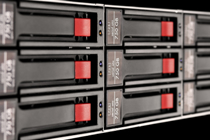Posts Tagged ‘HDD’
Thursday, November 4th, 2010

Hey, everyone, Josh from Computer Fitness back with another award-winning article to help you with your computer conundrums.
So you need a new computer? Well, it happens to all of us. Eventually our machines, even though they were once powerhouses, need to be replaced. Now, if you’ve been out of the game for a while, you might not know about everything you need to for today’s applications. Well, here are some things to look for when picking up or building a new computer.
Processor (CPU)
The CPU, or Processor, in a computer is what helps it perform most of its duties. The CPU allows the computer to solve equations, execute tasks, etc. The faster this is, the quicker programs will run. Now, for today’s applications, you want something in the Dual Core line with at least 2.5 GHz for each core. If you really want a screaming fast machine, go with a Quad Core at 3.0 GHz or more. The latter is good for gaming or advanced graphical work, while the former will be good for day to day processing without the need for upgrades in the near future.
Memory (RAM)
While the CPU helps to run programs, the RAM assists. RAM is temporary memory used to store the data needed to run programs. RAM holds the data and the CPU processes it. Now, you want at least 2GB of DRR2 RAM these days, though 4GB of DDR3 RAM would be better. Most operating systems will use up 1GB to start, so you’d already be 50% down with 2GB. Better to go with the 4GB, in my opinion.
Storage Space (Hard Drive)
Think of this like your brain’s long-term memory. You use the Hard Drive (HDD) to store data permanently. This is used to hold your operating system, photos, documents, etc. Bigger is better here, so go with at least 400 GB. Now, if you’ve embraced the digital age and frequently purchase games, movies, and music online, I’d recommend going with 1 TB for your HDD. You’ll avoid needing a backup soon, besides using multiple drives can get complex.
-Josh
Computer Fitness

Tags: HDD, mac, new computer, pc, RAM, Specs
Posted in Hardware Overview, Mac and PC, PC | No Comments »
Thursday, June 17th, 2010
 Hello and welcome to Computer Fitness’ Blog! My name is Josh. Computer Fitness is a tech support firm for small and medium businesses in Reisterstown, MD. Our areas of expertise run the gamut from workstation repair to server maintenance. Hello and welcome to Computer Fitness’ Blog! My name is Josh. Computer Fitness is a tech support firm for small and medium businesses in Reisterstown, MD. Our areas of expertise run the gamut from workstation repair to server maintenance.
So you’ve got a Mac and that’s awesome. You like the OS, the feel, whatever. However, you still need to run some Windows apps so you figure you’ll do that natively. It makes sense. So you get your copy of Windows and your Mac OS X disc and begin the process.
Now that you’ve gotten Windows installed, you’ll need to access your Mac side unless you want to waste precious disk space. The best part is, you can do this. First, make sure you have the latest version of Boot Camp for Windows. It comes from the OS X disc and is also available online from Apple. Once you install it, you can get read-only access to your OS X side! However, let’s say you have an external drive.
If you have an external drive, you will likely want to share files. To do this, you will need to format the drive. In Windows, view the drive in My Computer and right click on it. Now, format it in FAT format. This stands for File Allocation Table format. This is the only format that both Windows and MAC can read/write to.
Lastly, if you want to use part of your external as a Time Machine drive and the other half for Windows, you can do that, too. Open up Disk Utility in Mac OS X and select the drive you want to partition. Then, drag the slider on the left to indicate how you want it split. Now, you can partition the drive. Next, format one part as Mac OS X Journaled and the other as FAT. You can now use an external drive as two different drives!
-Josh
Computer Fitness
Onsite and Remote Tech Support

Tags: Apple, Formatting, HDD, Windows
Posted in Mac and PC | No Comments »
Thursday, May 27th, 2010
 Hello and welcome to Computer Fitness’ Blog! My name is Josh. Computer Fitness is a tech support firm for small and medium businesses in Reisterstown, MD. Our areas of expertise run the gamut from workstation repair to server maintenance. Hello and welcome to Computer Fitness’ Blog! My name is Josh. Computer Fitness is a tech support firm for small and medium businesses in Reisterstown, MD. Our areas of expertise run the gamut from workstation repair to server maintenance.
If you’re looking to get a new hard drive or computer, one of the first things you’ll likely look at is the size of the drive. You’ll try to figure out how much space you use now and how much you think you’ll use in the future. All of that is great, but a growing option for the hard drive is now the choice of a traditional drive, which utilizes spinning plates to hold data, or a solid state drive, which is very similar to the memory cards used in cameras, iPods, etc. This may not seem important at first, aside from the price. However, take a close look at three things to consider when buying a new hard drive.
1) Solid State Drives Have No Moving Parts
This is a winner for all you laptop owners out there who keep dropping your machine. Since there are no moving parts, falling won’t damage any delicate equipment located on the inside of the drive. A traditional drive might crash if dropped. Solid State drives win here. However, if you are getting a desktop, don’t even worry about this part.
2) Traditional Hard Drives Last Longer
Not too long ago, solid-state drives were said to have a lifespan of about two years. They’ve doubled that since then, but the fact of the matter is that a traditional drive was last longer. If you’re a techie who is always upgrading, this may not be a concern for you. However, it is something to consider.
3) Solid State Drives are VERY Expensive
If it just comes down to money for you, a solid-state drive is not your choice. They are much more expensive. This is due to the newness of the technology, combined with what it takes to make them. If you are looking for crash protection for a laptop, it might be worth the money. Otherwise, go with the traditional drive.
That’s all for this week. Check back again for more computer fitness tips!
-Josh
Computer Fitness
Onsite and Remote Tech Support

Tags: hard drive, Hardware, HDD, Solid State Drive, SSD
Posted in Hardware Overview | No Comments »
|










